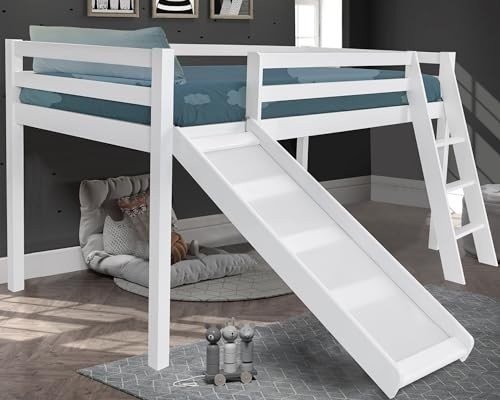A Comprehensive Guide to Children's Bunk Beds: Styles, Benefits, and Safety Considerations
Bunk beds have ended up being a popular option for households looking to take full advantage of space and provide an enjoyable sleeping environment for children. With their special design, they provide an imaginative and practical option for shared bedrooms, playrooms, and even guest accommodation. This post checks out the various styles of children's bunk beds, their benefits, security factors to consider, and responds to some regularly asked questions.
The Allure of Bunk Beds
Kid's bunk beds are more than just space-saving structures; they are likewise an entrance to adventurous dreams and imaginative play. Below is a comprehensive assessment of their various benefits.
Advantages of Bunk Beds
- Space-Saving: Bunk beds efficiently utilize vertical space, making them an ideal choice for smaller sized rooms.
- Spirited Design: Many bunk bed styles consist of slides, camping tents, and themed elements, sparking creativity and enjoyment.
- Partner Sharing: Bunk beds are ideal for brother or sisters sharing a room or accommodating slumber parties.
- Flexible Use: Some designs can be separated into two private beds, providing flexibility as children grow.
- Storage Options: Many bunk beds include built-in drawer storage or racks, further improving their practicality.
Styles of Children's Bunk Beds
The range of bunk beds readily available today deals with various choices and needs. Below is an overview of some popular designs.
| Style | Description | Best For |
|---|---|---|
| Standard Bunk Bed | A standard style featuring one bed stacked above another. | Brother or sisters sharing a space. |
| Loft Bed | Similar to a bunk bed without the bottom bunk, enables a work area or play area listed below. | Minimal space for play/desk. |
| L-Shaped Bunk Bed | 2 beds arranged in an L-shape, frequently with extra sections for storage or play. | Unique room layouts. |
| Twin Over Full | A twin bed over a full bed, accommodating different sleep requirements. | Growing kids and teens. |
| High Sleeper | Stands even greater than a loft bed, generally featuring a desk or play area below. | Older kids requiring more play/desk space. |
| Tent Bunk Bed | Bunk beds with a canopy or tent-like structure, producing a comfortable, enjoyable space. | Active and creative children. |
Key Features to Consider
When picking the ideal bunk bed for children, the following functions are worth thinking about:
- Material: Bunk beds can be made from wood, metal, or a combination. Each has its unique visual and resilience.
- Weight Capacity: Always validate the weight limit of the bunk bed to ensure it can accommodate your children securely.
- Safety Rails: Ensure the leading bunk has strong rails to prevent falls.
- Ladder Security: A properly designed ladder ought to use easy and safe access to the upper bunk.
- Finishing: Ensure any finishes are non-toxic and safe for kids.
Safety Considerations
Security is critical when it concerns children's bunk beds. The following standards ought to be stuck to:
- Age Appropriateness: Generally, children under 6 years old need to not sleep in the upper bunk due to safety risks.
- Durable Construction: Ensure the frame and products are strong and can support the weight without drooping.
- Regular Maintenance: Periodically examine for loose screws, bolts, or other elements that might need tightening up.
- Clear Play Area: Keep the area around the bunk bed totally free of toys and obstacles to lessen tripping risks.
Setting Rules for Safe Use
Developing standards for bunk bed use will assist guarantee safety:
- Limit Jumping and Climbing: Children must be recommended versus leaping from the top bunk and getting on the sides.
- Monitoring Sleepovers: Monitor young guests while they are utilizing the bunk bed for the very first time.
- Educate on Ladder Use: Teach how to use the ladder securely, stressing the significance of dealing with the ladder when climbing or down.
Often Asked Questions
1. What Best Bunk Bed antonedando.top is suitable for a child to sleep in the leading bunk?
A lot of producers recommend that children should be at least six years of ages to sleep in the upper bunk. This guideline is created to alleviate the threat of falls.
2. Can bunk beds be personalized?
Yes, numerous manufacturers offer adjustable choices, consisting of colors, products, and extra features like drawers or desks.
3. Are bunk beds safe for weight?
Bunk beds have weight limitations, typically varying from 200 to 400 pounds, depending on the design and product. Constantly check the producer's specifications.
4. How do I preserve and clean up a bunk bed?
Routinely inspect for loose parts, keep the bed tidy by cleaning down surface areas, and ensure the bedding is fresh to promote a safe and sanitary sleep environment.
5. Can bunk beds be separated into individual beds?
Lots of bunk beds come with an alternative to separate them into 2 private beds, offering long-lasting adaptability.
Children's bunk beds are more than mere furniture; they are a functional, versatile, and imaginative component of a kid's space. With various styles available and numerous safety considerations to keep in mind, parents can choose the ideal bed that fits their space, satisfies their kids's needs, and imparts a sense of experience. By understanding the advantages, designs, and safety steps related to bunk beds, households can develop a delightful and safe sleeping environment for their kids. Whether for siblings sharing a room or space-saving options, bunk beds stay a beloved option for numerous homes.

